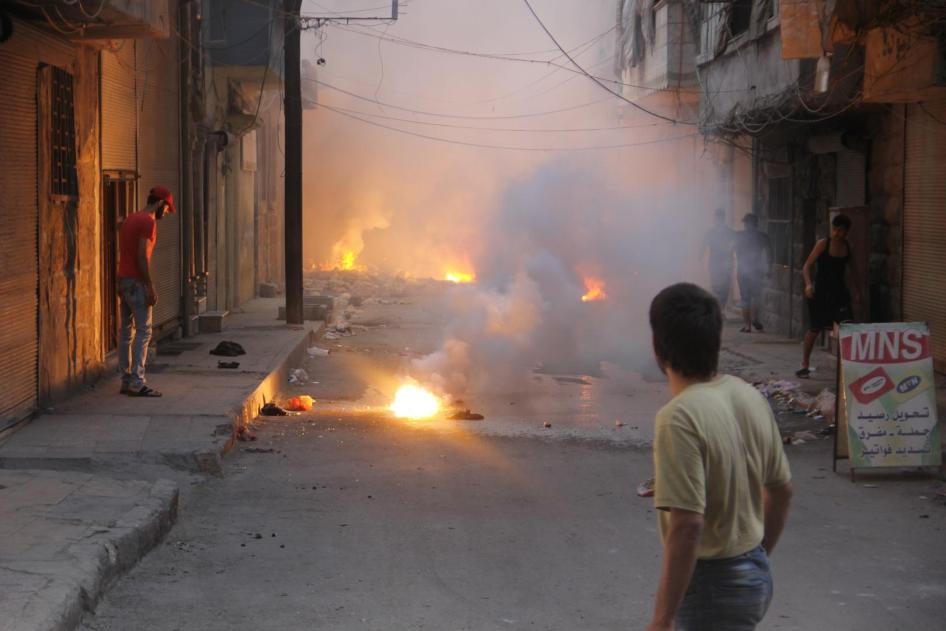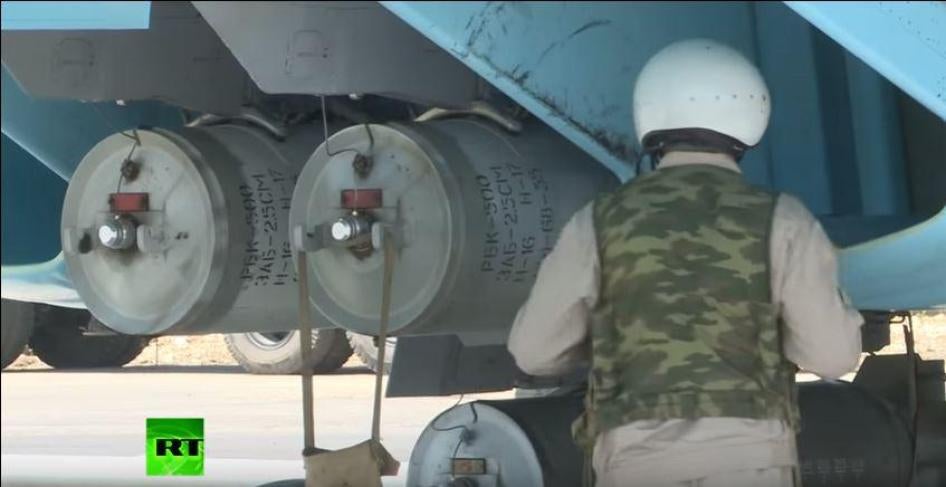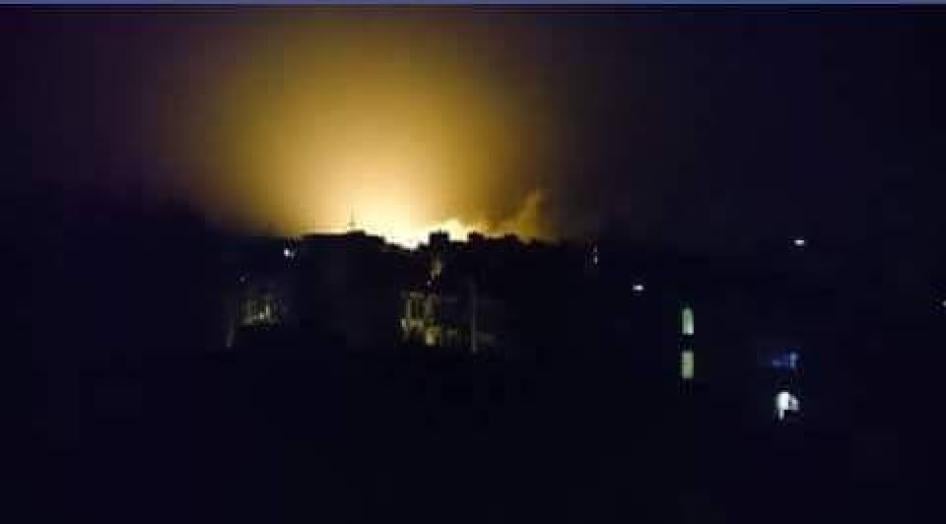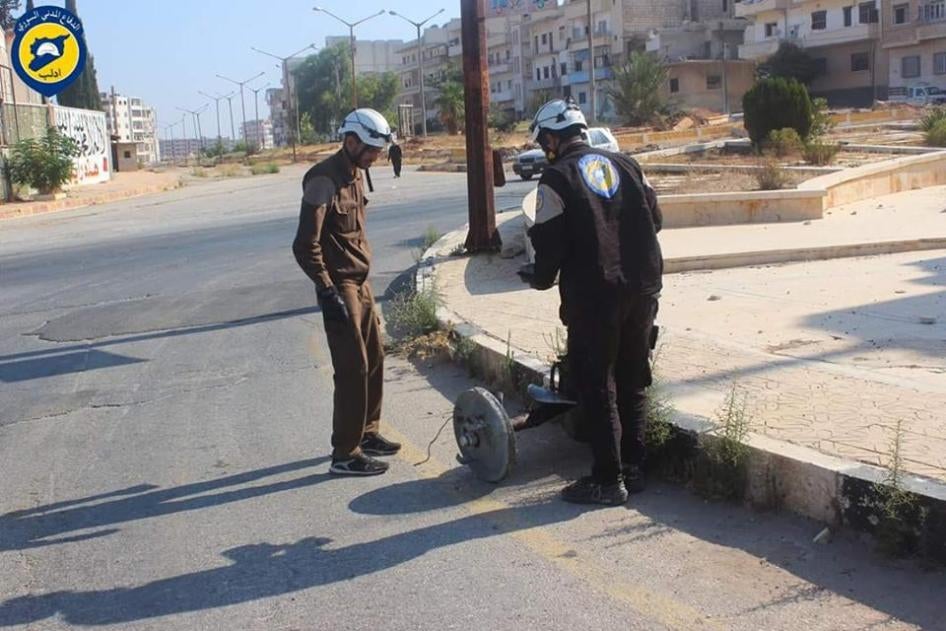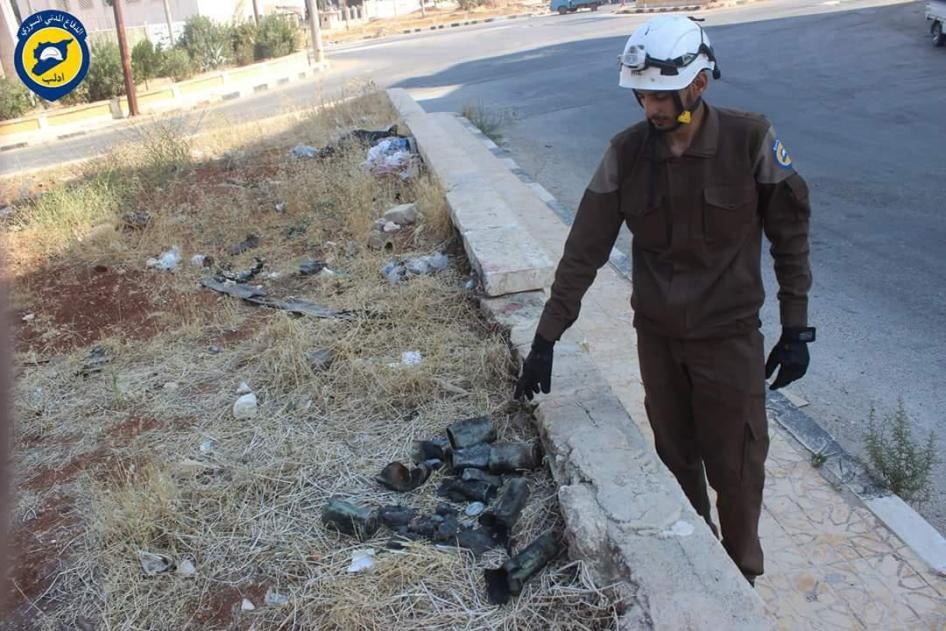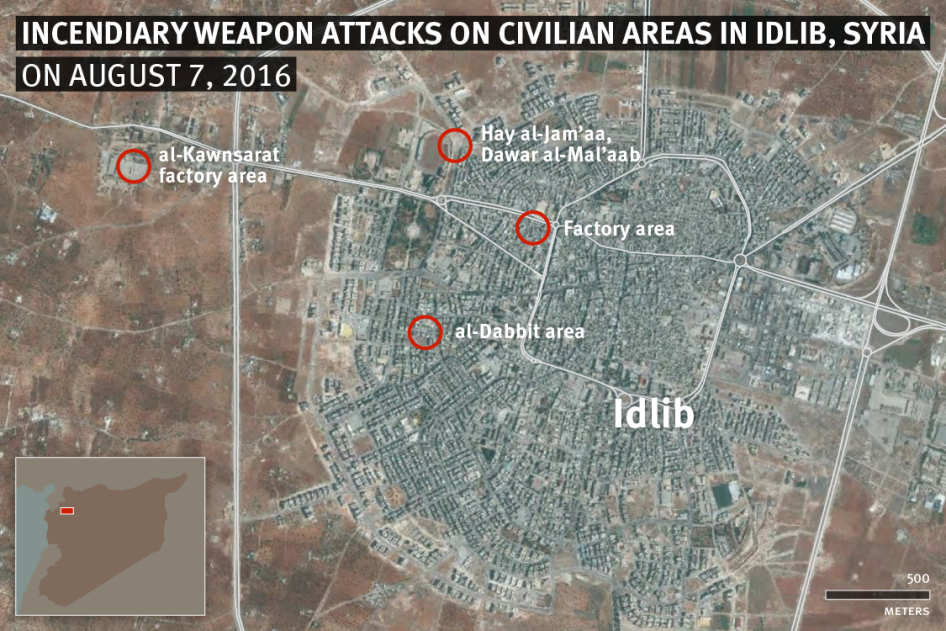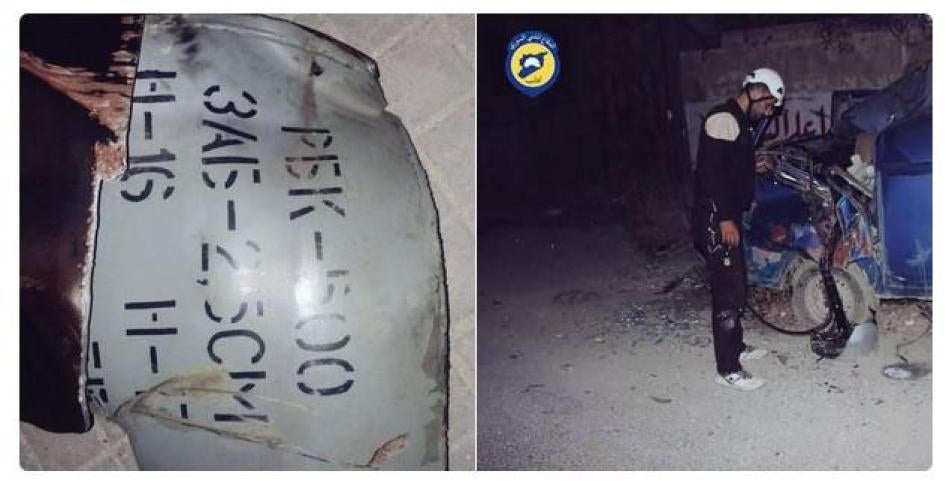An incendiary weapon attack on the opposition-held Idlib city on the evening of August 7 wounded at least two civilians, witnesses said.
“I saw with my own eyes two strikes, both ‘phosphorus’—blocks of flame were falling from the sky,” said. Ala’ Abdel Aziz Hmeidan, an Idlib resident. "After that, there was a strike with a missile carrying cluster bombs. It was tragic, buildings were on fire, rocks were on fire.” He said the area contains residential buildings and that there were no armed groups in the vicinity.
Syria Civil Defense, an opposition search-and-rescue volunteer group, reported an incendiary weapon attack on the residential area in al-Mashhad in opposition-held east Aleppo city at around 4 p.m. on August 7 that injured a child. Photographs taken immediately after the attack by Aleppo resident Malek Tarboush show at least four incendiary submunitions burning on the ground in a narrow street that contains at least one shop. Human Rights Watch was unable to identify the specific type of incendiary weapon used in the attack.
Incendiary weapon attacks in Syria have increased significantly since the Russian Federation began its joint military operation with the Syrian government on September 30, 2015. There is compelling evidence that Russian government aircraft are being used to deliver incendiary weapons or at least are participating with Syrian government aircraft in attacks using incendiary weapons.
More than a dozen countries have condemned or expressed concern at the use of incendiary weapons in Syria since 2013, including Colombia, Sweden, Turkey, UK, and the US in recent weeks. The other states that have condemned the use of incendiary weapons in Syria are Austria, Croatia, Ecuador, France, Germany, Ireland, Lithuania, the Netherlands, Norway, and Switzerland.
“The disgraceful incendiary weapon attacks in Syria show an abject failure to adhere to international law restricting incendiary weapons,” Goose said. “The resulting civilian harm demonstrates the inadequacy of existing law on incendiary weapons, which should be strengthened urgently. From a humanitarian standpoint, a global ban on incendiary weapons would provide the best solution.”
For more information about the incendiary weapons protocol, details of the recent attacks, and evidence of the use of incendiary weapons, please see below.
Goose and Human Rights Watch arms advocacy director Mary Wareham are attending the week-long CCW meeting that opens in Geneva on August 29, 2016.
The Incendiary Weapons Protocol
Russia is a party to the incendiary weapons protocol and has acknowledged the “significant humanitarian damage” caused by incendiary weapons in Syria, which it attributed to “improper use,” in a November 2015 letter to Human Rights Watch.
Russia has not responded to criticism of its apparent involvement in recent incendiary weapon attacks in Syria. In November 2015, Russia urged “faithful observation” of international law relating to incendiary weapons, but rejected calls to revisit and strengthen Protocol III on incendiary weapons of the conventional weapons treaty as “counterproductive.”
The Syrian government has ignored calls to join Protocol III, which 113 countries are party to, including Russia and the other permanent members of the United Nations Security Council. The protocol bans the use of air-delivered incendiary weapons in areas with “concentrations of civilians,” but permits the use of ground-launched incendiary weapons.
Protocol III defines “concentrations of civilians” broadly as “any concentration of civilians, be it permanent or temporary, such as in inhabited parts of cities, or inhabited towns or villages, or as in camps or columns of refugees or evacuees.”
The treaty’s member countries should support the call to revisit and amend Protocol III to fix the significant loophole permitting use of ground-launched incendiary weapons in civilian areas. They should revisit the definition of incendiary weapons in Protocol III as it is overly narrow and fails adequately to deal with multi-purpose incendiary munitions such as white phosphorus. These and other inconsistencies have undermined the protocol’s effectiveness and failed to deter use of incendiary weapons over the past 35 years, Human Rights Watch said.
Idlib city, Idlib governorate, August 7, 2016
Mouti’ Jalal, a volunteer with Syria Civil Defense in Idlib told Human Rights Watch:
I was at home in Sarmin, Idlib. I heard volunteers radioing in about two strikes. They were saying it was phosphorus. I grabbed my camera and was on my way. I saw fire falling from the sky. But couldn’t get to the area because the roads were under attack. The fire was so bright, you could see it from outside the city and everyone saw it. I had a clear view of the phosphorus falling on my way but unfortunately my camera was slow and couldn’t get a picture at the right moment.
An Idlib resident, Mohammad Taj Al-Din Othman, provided Human Rights Watch with photos he took of the attack that contain metadata showing they were taken at 23:03 and 23:08 local time on August 7, 2016. Othman said:
The first missile disintegrated in the sky and fell down in pieces. It wasn’t too loud but it led to a huge fire as soon as it hit the ground. Other explosions followed. And it made the fire worse. I could clearly see the flames bursting. Within 10 minutes, there were more strikes. The fire was unbelievable, it turned night into day. Across fifty square meters. And it kept getting worse for five minutes.
A second Syria Civil Defense (SCD) Idlib volunteer who asked not to be named said:
It was night and calm; we could clearly hear warplanes circling. It was a frightening sound. I also saw a missile get launched from the plane, a bright spot in the sky, along with a terrible blast. SCD was unable to determine the nature of the weapon used but we know for a fact that it was highly flammable.
Video and photos recorded at the time of attack and afterward of the remnants show the use of RBK-500 ZAB-2.5SM bombs, an incendiary weapon that delivers 117 ZAB-2.5SM incendiary submunitions. The witness accounts and visual evidence confirm this was an incendiary weapon attack.
Each ZAB-2.5SM submunition burns for up to 10 minutes, starting fires that are hard to extinguish. Numerous photographs and videos from the Idlib attack clearly shows individual fires between residential buildings started by burning submunitions.
The ZAB-2.5SM submunitions delivered by RBK-500 bombs contain a small bursting charge to ignite the flammable substance as they are released from the bomb in mid-air. The fires started by incendiary weapons can also cause secondary explosions when they burn objects on the ground.
Jalal, the Syria Civil Defense volunteer, said that the multiple airstrikes that evening wounded approximately 10 people. He told Human Rights Watch: “Some had burns, but most had just concussions and fractures.”
Yahya A’arja, the Idlib director of Syria Civil Defense, who responded to one of the August 7 attack sites, said the incendiary weapons “fell on the street, luckily not on homes, and only burned cars.” He said that “the smell led to suffocation, injuring two. No burns at all, thank God. Only asphyxiation from the smell because it wasn’t on their bodies.” The victims were treated at the scene. “Oxygen therapy was administered inside the ambulance,” A’arja said.
According to the unnamed Syria Civil Defense volunteer, the airstrikes consisted of four attacks [including] on “a large crowded residential neighborhood of Idlib city known as al-Dabbit.” He said, “I can confirm that there is no military presence in that area.”
Othman provided Human Rights Watch with a list of four locations in the city that were attacked by incendiary weapons on August 7:
- al-Dabbit, near the university’s faculty of humanities;
- Hay al-Jam’aa, in the Dawar al-Mal’aab neighborhood;
- al-Konsorwa industrial area; and
- al-Ghazl industrial area.
Othman said during the attack on the university’s faculty of humanities at al-Dabbit, incendiary bombs “fell between houses and people were terrified and started panicking, they even went out of their homes.” He described Hay al-Jam’aa as “a typical residential area” that was hit first by incendiary weapons that “fell in the middle of the street” rather than on homes, thereby minimizing damage. He said the university still functions, but there were no classes at the time of the evening attack. The area also has a small supermarket and a coffee shop. He said the al-Konsorwa industrial area that was attacked has a factory that is no longer used and is “not residential per se but there are many displaced people there.” It “used to be a Syrian army checkpoint.”
Othman said that “armed groups are stationed around the city but they weren’t targeted” in the incendiary weapon attacks on August 7. He said “the strikes were repetitive and you could hear the plane in the sky, it was very loud and continuous. I only saw the plane when it launched the first missile. I think it was Russian. And it was just one plane.”
Two teams of Syria Civil Defense volunteers from Idlib extinguished the fires started by the attack and gathered and destroyed remnants of the incendiary weapons even though they had no expertise with them. Jalal said they were told to use gravel to extinguish the fire because “water makes it worse.”
A Syria Civil Defense volunteer who responded to the attack told Human Rights Watch:
The fire was vast, spreading hundreds of meters, difficult to put out. It reacted with water so we had to use other material, like foam and powder, even gravel. The fire took over everything, houses, cars, oil tanks, and even grass. We heard explosions. It was huge, it required immense efforts to extinguish. The tall, crowded buildings did not make things easy. It took us around an hour to control the situation. It was so bright you could see the buildings as if was daylight. It was absolutely abnormal. Honestly, words cannot describe it.
Technical Background and Recent Attacks
Since November 2012, Human Rights Watch has recorded the use of four types of incendiary weapons in Syria, all ZAB-series (Zazhigatelnaya Aviatsionnaya Bomba) incendiary aircraft bombs manufactured by the Soviet Union:
- RBK-500 ZAB 2.5SM bomb, each containing 117 ZAB 2.5SM incendiary submunitions
- RBK-250 ZAB-2.5 bomb, each containing 48 ZAB-2.5 incendiary submunitions
- ZAB-100-105 bomb, each containing nine cylindrical incendiary cartridges
- ZAB-500 unitary incendiary bomb
ZAB-series bombs contain a substance believed to be thermite that ignites while falling, leading witnesses to describe the incendiary submunitions as “fireballs.” It is not napalm or white phosphorus, which are notorious flammable substances used in other incendiary weapons.
The majority of witness accounts collected by Human Right Watch and video evidence indicate that fixed-wing jet aircraft and helicopters have been used to deliver air-dropped incendiary weapons in Syria. There has been at least one incident involving the use of a surface-launched incendiary weapon.
The Syrian government has used factory-made incendiary weapons since November 2012, particularly air-dropped bombs manufactured by the Soviet Union such as RBK-250 series bombs and ZAB-100-105 bombs. Syrian government forces have also used air-dropped weapons consisting of improvised canisters or “barrel bombs” filled with a napalm-like flammable substance.
Footage broadcasted by Russian state media on June 18 shows RBK-500 ZAB-2.5SM incendiary bombs mounted on a Su-34 fighter-ground attack aircraft at the Russian air base at Hmeymim, southeast of Latakia city, in Syria. Only the Russian air force operates this type of aircraft in Syria.
Documented Incendiary Weapon Attacks, June 5-August 10, 2016
|
Date |
Location |
Casualties (source) |
Type of Incendiary Weapon |
Visual Confirmation |
|
August 10 |
Qubtan al-Jabal, Aleppo |
None reported |
RBK-500 ZAB-2.5SM |
|
|
August 7 |
Idlib city, Idlib |
2-10 reported wounded (SCD) |
RBK-500 ZAB-2.5SM |
|
|
August 7 |
Aleppo city, Aleppo |
1 reported wounded (SCD) |
Not available |
|
|
July 7 |
Kafr Hamrah, Aleppo |
None reported |
Not available |
|
|
June 26 |
Saraqeb, Idlib |
1 reported wounded (SCD) |
RBK-500 ZAB-2.5SM |
|
|
June 26 |
Kafr Halab, Aleppo |
None reported |
Not available |
Media N/A |
|
June 24 |
Kafr Hamra, Aleppo |
None reported |
Not available |
|
|
June 23 |
Khan al-Asal, Aleppo |
None reported |
Not available |
|
|
June 22 |
Hayyan, Aleppo |
None reported |
RBK-500 ZAB-2.5SM |
|
|
June 22 |
Kafr Naya or Urum al-Kubrah, Aleppo |
2 reported wounded (SCD, witness) |
RBK-500 ZAB-2.5SM |
|
|
June 20 (approximate) |
Hraytan (Haritan), Aleppo |
None reported |
RBK-500 ZAB-2.5SM |
|
|
June 20 |
Hayyan, Aleppo |
None reported |
RBK-500 ZAB-2.5SM |
|
|
June 19 |
Anadan, Aleppo |
None reported |
Not available |
|
|
June 16 |
Ma’ar Shoreen, Idlib |
None reported |
Not available |
Photos on file |
|
June 15 |
Anadan, Aleppo |
None reported |
RBK-500 ZAB-2.5SM |
|
|
June 11 |
Kafr Halab, Aleppo |
6 reported wounded (Smart News Agency) |
RBK-500 ZAB-2.5SM |
|
|
June 10 |
Kafr Hamra, Aleppo |
None reported |
RBK-500 ZAB-2.5SM |
|
|
June 5 |
Anadan, Aleppo |
None reported |
RBK-500 ZAB-2.5SM |
